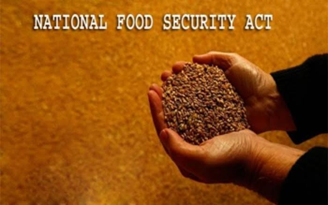The National Food Security Act (NFSA),2013
Relevance
- GS Paper 2 Issues Relating to Development and Management of Social Sector/Services relating to Health, Education, and Human Resources.
- Issues relating to Poverty and Hunger.
- Tags: #UPSC #GS2 #NFSA2013 #FoodSecurity #TDPS #PovertyAndHunger #Hunger
The National Food Security Act (NFSA) of 2013 is a landmark piece of legislation that aims to transform India’s food security landscape. Rooted in the right to food, this act is designed to ensure that no citizen in the country goes to bed hungry. The enactment of the National Food Security Act, (NFSA) 2013 on July 5, 2013 marks a paradigm shift in the approach to food security from welfare to rights based approach.
Provisions of the NFSA
Entitlements Under Targeted Public Distribution System (TPDS)
- The NFSA entitles beneficiaries to receive food grains from the TPDS at subsidized prices.
- The act covers 2 categories:
- Priority Households (PHH)
- Antyodaya Anna Yojana (AAY) households.
- Priority households are provided 5 kg of food grains per person every month, while the Antyodaya Anna Yojana households receive 35 kg per family.
- Identification of Beneficiaries/ Coverage: The states and union territories identify beneficiaries for the TPDS based on the socio-economic and household criteria.
- NSSO’s Household Consumption Expenditure survey: 2011-12 is used by NITI AAyog to determine state wise coverage of households. Act covers Upto 50 % of Urban Population and upto 75% of Rural Population.
- About two thirds of the population therefore is covered under the Act to receive highly subsidized food-grains.
- To enhance transparency and minimize errors, the NFSA calls for the use of technology in the identification process.
Nutritional Support to Pregnant and Lactating Women
- The NFSA provides for the distribution of maternity benefits to pregnant and lactating women.
- They are entitled to receive nutritious meal free of cost through a widespread network of Integrated Child Development Services (ICDS) centres, called Anganwadi Centres under ICDS scheme and also through schools under Mid-Day Meal (MDM) scheme
- This includes a cash transfer of ₹6,000, ensuring their nutrition and health.
Child Nutrition
- Children aged 6 months to 14 years are entitled to free school meals.
- Higher nutritional norms have been prescribed for malnourished children 6 years of age.
- This not only addresses malnutrition but also promotes school attendance and retention.
Food security allowance
- If entitled individuals do not receive the specified food or meals under NFSA, they can claim a food security allowance from the respective State Government.
Transparency and Accountability
- The Act requires the state governments to put in place a grievance redressal system, thereby making the implementation process more transparent and accountable.
Issue Price Under NFSA
- Food-grains under NFSA were to be made available at subsidized prices of Rs. 3/2/1 per kg for rice, wheat and coarse grains respectively.
- Prices were to be fixed by the Central Government from time to time, but not exceeding MSP.
Objectives of the NFSA
The NFSA is framed with the following objectives in mind:
- Food for All: The primary aim is to provide food security to the entire population of the country, ensuring no one goes to bed hungry.
- Reduction of Malnutrition: By targeting vulnerable sections, especially pregnant women and children, the Act seeks to reduce malnutrition and improve overall health.
- Empowerment: By enhancing the livelihoods of the marginalised sections through various welfare measures, the NFSA aims to empower them.
- Strengthening TPDS: The Act seeks to strengthen the TPDS, making it more efficient and accountable.
- Promoting Child Welfare: By introducing free school meals, the NFSA supports child welfare, better attendance, and educational outcomes.
Responsibilities of Centre and State Government Under NFSA
Centre’s Responsibilities
- Allocation of required food-grains to States/UTs.
- Transportation of food-grains to designated depots in each State/UT.
- Providing central assistance to States/UTs for food-grain delivery from FCI godowns to FPSs.
States/UTs’ Responsibilities
- Effective implementation of NFSA.
- Identifying eligible households.
- Issuing ration cards to eligible households.
- Distributing food-grain entitlements through fair price shops (FPS).
- Licensing and monitoring of Fair Price Shop dealers.
- Establishing grievance redressal mechanisms.
- Strengthening the Targeted Public Distribution System (TPDS).
Challenges in Implementing the NFSA
- Identification of Beneficiaries: One of the significant challenges is the identification of beneficiaries. States often struggle to accurately determine those eligible for food subsidies.
- Leakages in the TPDS: There are instances of leakages in the TPDS, leading to diversion of subsidized food grains to the open market.
- Fiscal Implications: Implementing the NFSA has significant fiscal implications for the government. The subsidy bill for food grains can be a financial burden.
- Storage and Distribution: Ensuring proper storage and timely distribution of food grains is a logistical challenge.
- Regional Disparities: Disparities exist in the implementation of the NFSA across states. Some states perform better in reaching beneficiaries than others.
Advantages of the NFSA
- Poverty Alleviation: The Act helps reduce poverty by providing food grains at subsidized rates to economically weaker sections.
- Health Improvement: The nutrition provided under the Act enhances overall health, particularly among pregnant women and children.
- Women Empowerment: The eldest woman of the household of age 18 years or above is mandated to be the head of the household for the purpose of issuing ration cards.
- Right to Food: The NFSA recognizes the right to food as a fundamental right, reinforcing social and economic rights.
- Inclusive Growth: The Act contributes to more inclusive growth by focusing on the welfare of marginalized sections.
Criticism of the NFSA
- Leakages and Corruption: Critics argue that the NFSA is plagued by leakages, corruption, and inefficiency in the distribution system, which dilutes its impact.
- High Fiscal Cost: The Act’s fiscal cost is seen as unsustainable, straining the government’s budget.
- Food Grain Procurement: The Act’s emphasis on food grain procurement can lead to a distorted incentive structure in agriculture.
- Limited Coverage: The NFSA primarily targets the below-poverty-line (BPL) population, potentially excluding many who are economically vulnerable.
- Inequitable Access: There are concerns that certain regions and communities have inequitable access to the benefits of the NFSA.
Way Forward
- Efficient Implementation: To maximize the benefits of the NFSA, states should strive for efficient identification and distribution systems, leveraging technology for transparency.
- Strengthening TPDS: Efforts should be made to improve the infrastructure and supply chain management of the TPDS to reduce leakages.
- Inclusivity: Expanding the scope of beneficiaries to cover a wider section of the economically vulnerable population can enhance inclusivity.
- Economic Reforms: Complementary economic reforms are necessary to create jobs and uplift people from poverty, thus reducing the need for food subsidies.
- Transparency: Ensuring transparency in the grievance redressal mechanism can help address beneficiary issues effectively.
National Food Security Act (2013) provides for reforms in the TPDS including schemes such as Cash transfers(DBT) for provisioning of food entitlements.
The National Food Security Act, 2013, is a vital step towards ensuring that no one in India goes to bed hungry. Its success lies in efficient implementation, addressing challenges, and adapting to changing socio-economic conditions. By providing food security, empowering women, and promoting child welfare, the Act plays a pivotal role in the country’s socio-economic development, making it a cornerstone of India’s welfare initiatives.
Mains Question
The National Food Security Act, 2013, is a landmark piece of legislation with the objective of transforming India’s food security landscape. Discuss the provisions and challenges associated with this act. How can efficient implementation and inclusive policies address the issues raised by critics? Explain.





